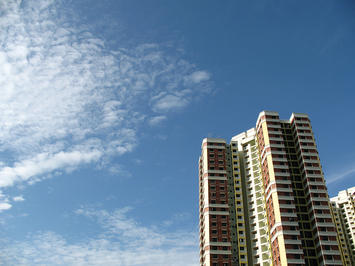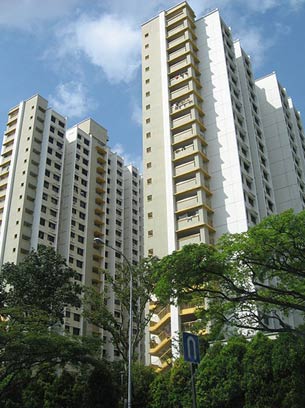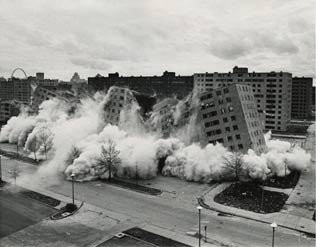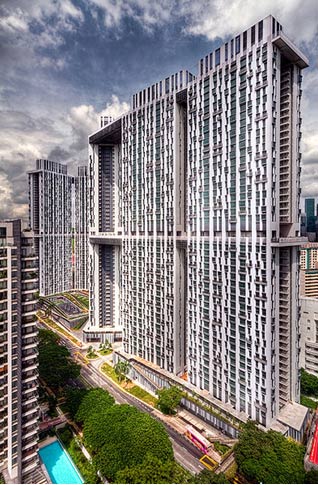
Imagine a future America where the home ownership rate climbs from the current 65%1 to 87%2. Libertarians as well as many social democrats would be cheering. Imagine that this rate was achieved by the state itself acting as the builder of 88%3 of the housing. Imagine also that the state imposes rules on home purchases to favor first time buyers and young families. “Progressives”, increasingly tilted towards the unmarried and childless, would bristile. Imagine racial diversity rules that restrict who you can sell your home to. Time for libertarians to shudder.
Most Americans would probably say such a concept is “Utopian” but serious policy makers should reflect that the word “Utopia” literally means “nowhere”. But Social Market Housing is alive and well in Singapore.
For Americans living in the hottest real estate markets, the USA is very far from the ideal of a Property Owning Democracy. At the time of the 2010 census three of New York City’s five boroughs had home ownership rates under 30% and in the Bronx it was under 20%4. Though many US politicians support the concept of home ownership it has been declining since 1980 when it reached a peak of 68%5.

How have the Singaporeans achieved such high ownership rates despite having the richest economy in South East Asia? Many factors come into play. Singapore has an aggressive building program achieved through a public body - the Housing Development Board (HDB). HDB apartments can only be sold to Singapore citizens and those with permanent resident status, so their prices cannot be inflated by foreign speculators.
The HDB also has eminent domain powers to claim land if it needs to. Singapore’s version of social security is not inter-generational (unlike the USA where the current generation of workers pays for the last generation of retirees) but rather an elaborate system of forced saving by both workers and their employers. Part of the compulsory savings can be used for a deposit on an HDB flat. Finally there is an elaborate system of price discounts on new HDB flats which is not only designed to favor first time buyers, but also young families and newlyweds.
There is even a category of ‘Executive Homes’ to retain managers in Singapore. These may be larger apartments or semi-detached homes with gardens.
There is no problem with runaway maintenance fees. HDB owners do not pay associations dues. Their elevators are maintained through local real estate taxes so monthly costs are very predictable. In the year 2010 the average Singaporean household paid $145 USD a month in property tax6
. This is less than the $216 average USD American Condo owners paid in condo fees at the time of the 2000 census.
Some Americans might argue that this can only work because Asians are conformist and are culturally more receptive to rule-based systems. I do find that South East Asians are reluctant to draw attention to themselves in public. When I talk in a Starbucks with my normal New York speaking voice I sometimes look up and find myself orating to a group of open-mouthed onlookers (“I’m so sorry it’s the Tourette’s Syndrome – my shrink keeps forgetting to up my dosage.”)
 Many US politicians recoil against the state as a real estate developer largely because tenanted housing projects have been such a magnet for social problems. The St. Louis public housing scheme, Pruitt-Igoe, was eventually dynamited (see photo right7). The author of “The Death and Life of Great American Cities”, Jane Jacobs, famously complained that the public housing projects took some mixed income neighborhoods which could have been viable and sealed their doom by concentrating too many low income and unemployed people in the same buildings.
Many US politicians recoil against the state as a real estate developer largely because tenanted housing projects have been such a magnet for social problems. The St. Louis public housing scheme, Pruitt-Igoe, was eventually dynamited (see photo right7). The author of “The Death and Life of Great American Cities”, Jane Jacobs, famously complained that the public housing projects took some mixed income neighborhoods which could have been viable and sealed their doom by concentrating too many low income and unemployed people in the same buildings.
Singapore’s HDB does act as a direct landlord for a very small number of people who meet a strict income ceiling (about $1160 USD a month8), however the low income tenants are spread thinly among owner occupiers. Income ghettoization is limited. My realtor tells me that one of the blocks in my own HDB estate is for tenants rather than owners but from the outside I cannot tell which building it is. Another form of deliberate social mixing takes the form of racial quotas intended to prevent the formation of ethnic enclaves. If the percentage of people in a given racial group has already met the national quota you can be blocked from selling or renting to a person in that category. Access to the more attractive and less attractive neighborhoods is thus shared out more equally. This looks like a policy American cities should consider given that the 14th amendment, busing and affirmative action have yet to produce full integration.
One aspect of America’s public housing projects that particularly angered Jane Jacobs was the wholesale removal of small retailers. In theory “The Projects” could have included small commercial spaces at the ground floor but generally public rental buildings in most of the US are considered to be danger zones where retailers fear to tread.
Typically the ground floor of HDB buildings is a void space where retailers can create businesses. Often they are left empty but sometimes the policy works well. Near Singapore’s Clementi MRT train station many dozens of “mom and pop” stores are now sheltering under the HDB apartments; late night street life is vibrant. When I ask Singaporeans to name a neighborhood that would be dangerous to go at night, nobody can think of one. The country’s homicide rate would pose an absolute disaster for TV script writers. You could not have a CSI series or Law and Order because Singapore would not be able to supply the requirement of one murder per week. The homicide rate is currently about one tenth of the USA’s9.

If she were alive today Jacobs might also criticize the HDB apartment blocks for excessive architectural uniformity. She loved communities to have buildings with different age profiles. But most of Singapore’s buildings are so new the option of preserving the old simply does not exist. Greater architectural variety is an attractive goal. One Singaporean architect commented that they will really have the styles right with you can build an HDB block next to a private condominium and you cannot tell which is which (a sort of urban planning version of the Turing Test). Local architects are point to a new HDB building, the Pinnacle at Duxton, as an example of a new look more comparable with private designs (pictured right).
But would greater variety cause costs to escalate? Observing new HDB construction it is possible to discern a very advanced form of modular building; entire concrete rooms are hoisted into the air at the end of a crane. Certainly a wider range of designs could be achieved using the same building blocks. Kids can make a huge variety of things with Lego. The same cuboids could also make homes with gardens which are America’s preferred form of housing--- a gift of an expansiveness impossible to achieve, except in dreams or by immigration, in Singapore.
Is Social Market Housing a good model for the USA? Certainly there would be many objections but the ideal of home ownership is too often an American Dream that disappears into a distant future. Are we doing enough to create a Commonwealth with “Liberty and Justice for All?” When they say the Pledge of Allegiance we force or children to use the words “Indivisible” and “One Nation”. Are we enough to make those words a reality?
Philip Truscott is a Senior Lecturer at Singapore University of Technology and Design
Notes:
Lead photo of HDB flats courtesy of BigStockPhoto.com. Other photo image files from http://commons.wikimedia.org
---------------------------------
2 SINGSTAT, (2011), “Statistics Singapore: Key Annual Indicators”, Singapore: Department of Statistics. Accessed on 19/11/2011 from <http://www.singstat.gov.sg/stats/keyind.html#hhld>.
3 SINGSTAT, (2008), “Key Indicators of Residential Households”, Singapore: Department of Statistics, Accessed on 19/11/2011 from <http://www.singstat.gov.sg/stats/themes/people/hhldindicators.pdf>.
4 US Census Bureau, (2011), “Housing Characteristics: 2010”, Washington DC: Bureau of the Census. Accessed on 19/11/2011 from <http://www.census.gov/prod/cen2010/briefs/c2010br-07.pdf>
5 This is based on a cross-tabulation of the variables “ownership” and “year” from the IPUMS online data analysis system at this URL http://sda.usa.ipums.org/cgi-bin/sdaweb/hsda?harcsda+1850-2009
6 Singapore Gross Property Tax Revenue from SINGSTAT, “Public Finance” at http://www.singstat.gov.sg/pubn/reference/yos11/statsT-publicfinance.pdf The number of resident households has been taken from the Census of Population 2010 at <http://www.singstat.gov.sg/pubn/popn/c2010sr2/t20-25.pdf>
7 Photo public domain: http://commons.wikimedia.org/wiki/File:Pruitt-Igoe-collapses.jpg
8 HDB, (2011), “Homes for All”, Singapore: Housing Development Board. Accessed on 19/11/2011 from < http://www.hdb.gov.sg/fi10/fi10221p.nsf/Attachment/AR0405/$file/home5_frameset.html>.
9 UNODC, (2011), “Homicide level for 2010, or latest available year”, Vienna: UN Office on Drugs and Crime, accessed on 17/11/2011 from < www.unodc.org/documents/data-and-analysis/statistics/Homicide/Homicide_level.xlsx >.













Great Post
Those core problems are the foods you eat and the unique enzymes inside those foods. Eating certain foods causes different effects within your body. By knowing which foods to eat to create different effects, you can take control of your cravings and maximize weight loss.e factor diet book
This is a great inspiring
This is a great inspiring article.I am pretty much pleased with your good work.You put really very helpful information. Keep it up. Keep blogging. Looking to reading your next post. here
Hey there thanks for showing
Hey there thanks for showing me this. I must say that your blogpost was the most enjoying read I've seen in a long time. Greetings from here Wow! What an eye opener this post has been for me. Very much appreciated, bookmarked, I can't wait for more! here There are a few options to consider before selecting pet cremation services. Some people only need a way to dispose of their pet's remains. This is generally the most inexpensive option. here
The government has announced
The government has announced plans to reform the hukou residency permit system. According to Zhang Yi, director of the Chinese Academy of Social Sciences research center is a system that "ensures freedom of migration." https://www.rebelmouse.com/venusfactorreviewslogin/
book on toilet training
Infant Potty Training was first published in 2000, is now in its third edition (2008), and has editions in German, Dutch, Italian and Japanese. Infant potty training is traditionally used in at least 80 countries. book on toilet training
With the current rate and
With the current rate and statistics, it shows how housing is in demand. By that time, a lot of Orange County realtor can benefit on the said increase of statistics.
fönsterdörrar
the growing component of anti-anti-sprawl policy analysts such as John Carlisle (Capital Research Center), Peter Gordon (USC School of Urban Planning), Peter Huber (Manhattan Institute), Mark Mills (Competitive Enterprise Institute), Steve Hayward (Pacific Research Institute), Anthony Downs (Brookings Institution), and Harry Richardson (Cascade Institute). fönsterdörrar
good in theory
I think the biggest problem with this setup is the natural selfishness that comes with being American. We want to feel that we own things, and that we've earned them. If there is a government agency put into place to doll out our 'biggest asset' in a mechanized and less meritocratic way then we won't feel like we earned it. Sure, the welfare class will jump for joy, but they already get to take advantage of that system. The simple fact of how profitable the home security industry is shows how much we care about owning and holding onto our own things.
Mixed Tenancy
This is nothing new to the US. In the 1980s, in Arlington, VA, I lived in a 500+-unit townhome complex that had been renovated from apartment rentals to condominiums. A couple of the 30-or-so buildings retained their rental status after renovation, and I believe accepted Section 8 vouchers or had some other income-based rental break. The rental buildings were indistinguishable on the exterior from the others, and I only knew about them because I had been personally told of them.
not a chance
Sorry, but this would never work in the US. Not in a million-billion years. Singapore isn't anything like the US. I wish the elites would stop looking at European and Asian models for the US. They just don't work here.
Why? Simple.
There is absolutely no need for the US government to involve itself further into the housing and real estate market. None.
If anything, the US government needs to get OUT of the real estate game.
How would the US government, which is largely totally incompetent in the areas it involves itself (think Fannie Mae and Mac etc) already. Frankly the thought of the social engineering that the government would have to do to bring on a Singapore style housing market on our country would be frankly horrifying. Just look at the social engineering it has attempted, its an utter disgrace.
The private market, when it is relieved of unnecessary and expensive government rules, red tape and over-regulation would likely increase home ownership without the huge tab that the taxpayers get stuck with today. Private developers frankly already do a pretty good job in a hostile and expensive environment. Imagine what they could do if they could do what they are supposed to do, build things instead of going to endless meetings with "planners". There is a reason why housing is plentiful, affordable in Texas but not in California.
Government "planning", even when well meaning, just doesn't work.